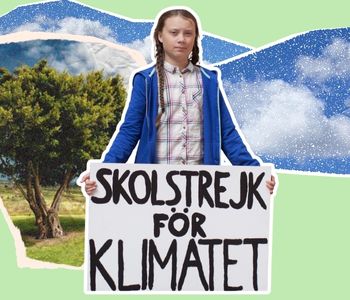

© Anders Hellberg
Table Of Contents
Earth Day is a time to reflect on how we impact the planet and consider ways to create a more sustainable future. Greta Thunberg, the Swedish environmental activist who founded Fridays for Future, has played a crucial role in raising awareness about global warming. In August 2018, she began her small campaign by missing school to sit outside the Swedish parliament with a sign that read “School Strike for Climate” in Swedish. Her movement quickly spread worldwide, inspiring millions of young people in over 163 countries to organize their own strikes. A year later, she received her first of three Nobel Peace Prize nominations for climate activism.
Exploring Greta’s activism and impact on the environmental movement is a great way to celebrate Earth Day—and can even inspire students to collaborate and take action in their own communities.
Use the following activities to kick-start research or lesson planning!
Climate for Beginners
Grades K-2
1. Emerging readers are just now beginning to learn about their environment—Greta is an excellent example of making activism a tangible concept! Show students the age-appropriate “Greta Thunberg” article in Britannica School and lead a discussion about how she wants to help the planet.
2. Use our open-access Draw to Understand instructional strategy to guide students pause, interpret, and visualize what they just learned about Greta.
3. Students can even share their drawings with the class!
Examine a Notable Figure
Grades 3-5
1. Hop over to Teach Britannica’s Researching and Writing Life Stories lesson mini, and use it to have students focus on Greta Thunberg. It’s a great way to integrate biographies and note-taking skills in class!
2. Ask students to consider:
3. Discuss what students have learned and ask them to present their findings to the class.
Speech Analysis
Grades 6-8
1. Use the Taking Notes and Citing Sources lesson mini in Teach Britannica to have students analyze one of Greta Thunberg’s speeches, such as her TED talk or United Nations Climate Action Summit speech.
2. As students practice their note-taking skills, ask them to consider:
3. After students have finished watching the video and taking notes, have them work in small groups to analyze and evaluate Thunberg’s speeches. Each group should present their analysis to the class.
4. Possible assessment questions include the following:
Biography Analysis
Grades 9-12
1. Use our Note-Taking Essentials lesson mini to kick-start students’ research into Thunberg. As students follow along the lesson mini, have them also consider the following questions:
2. Group students into teams to create a summary of Greta Thunberg’s life and activism. Each group should present its summary to the class.
3. Possible assessment questions include the following:
What’s Next?
Climate activism certainly only starts there! After analyzing Thunberg’s speeches and her background, have students brainstorm ways they can take action on climate change in their own community. Have them work in small groups to create an action plan, including specific steps they can take to reduce their carbon footprint and raise awareness about climate change. You can even use these activities to meet NGSS Earth Science standards.
Information sourced from Britannica School. Not a subscriber? Contact us to learn more.

About the Author
Kristie Bangali
Curriculum & Instruction Learning Specialist
Kristie, a Curriculum Learning Specialist at Britannica Education, has over 20 years of experience in pedagogy and curriculum development. She specializes in aligning educational content with academic standards and adapting to diverse student needs. Kristie’s proficiency with digital learning platforms was pivotal during the Covid-19 pandemic, earning her the 2020 LHRIC TELL Award and 2021 Teacher of the Year. She authored a chapter in “Gamify Literacy: Boost Collaboration and Learning,” published by the International Society for Technology in Education (ISTE), showcasing her innovative approach in education. Her impact extends beyond direct teaching, influencing the broader educational landscape.











